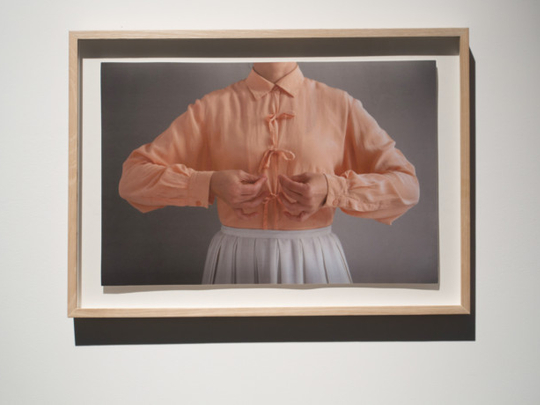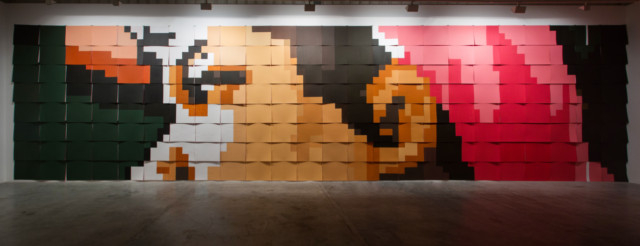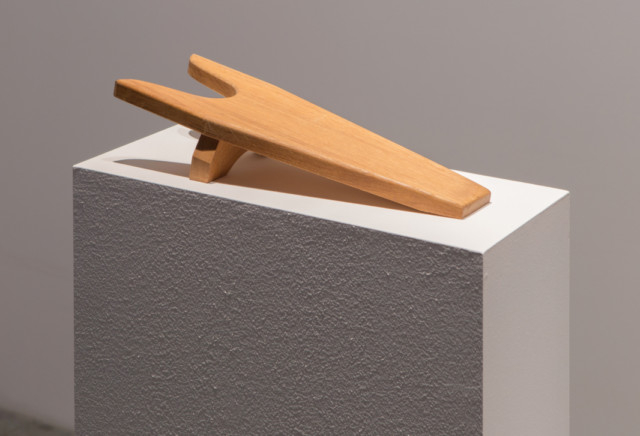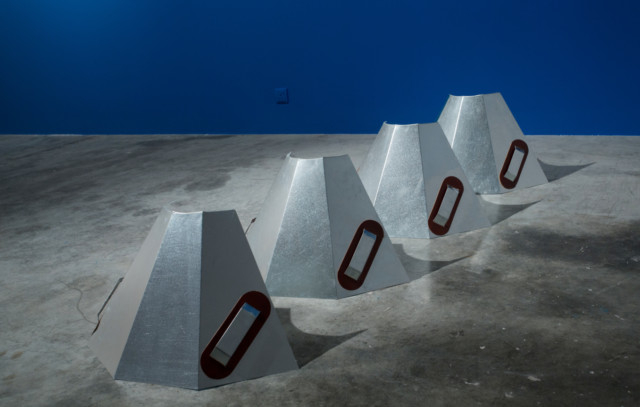
Ingrid Hora is interested in the relationship between the masses and their leaders. The Berlin-based Italian artist has done extensive research on the systems various leaders have implemented to cultivate mass following. Her latest show, “Dear Leader”, takes its name from the term used by North Koreans to address their leader. And the centrepiece of the show, “No Motherland Without You”, is inspired by the well-orchestrated glorification of the leader at the annual Arirang Mass Games held in the country. Composed of 192 hand-painted sheets of paper covering an entire wall in the gallery, the work references the giant mosaic pictures of the “Dear Leader” created in the stadium by more than 30,000 schoolchildren through perfectly choreographed moves.
Through the paintings, sculptures and installations in this show, Hora examines the social cement that holds a collective edifice together as well as the fragility of such a social structure. And she asks questions about how individuals cope with rigid systems and how they would be affected by the collapse of these systems. Hora’s work is essentially about the phenomenon of following and being followed and about collectivism and individuals in a collective, in situations that range from ideological brainwashing by despotic leaders to people blindly following latest fads. The artist spoke to Weekend Review about her fascination with choreographed systems and the various ways in which she investigates them. Excerpts:
Why did you place the photographic work “Positions of Leading” at the entrance to your exhibition?
When you look at a perfectly choreographed military band, it is so visually beautiful that you forget about the individuals in it or your concerns about war. It is the same with the mosaic pictures created by the children in North Korea. When I think about the mass following of many despotic leaders, I imagine that they operate like the conductor of an orchestra, who directs individual musicians in a group to create music. “Positions of Leading” depicts a person preparing to be a leader by training to be a conductor, and is an apt introduction to the theme of my show.
Tell us about your experiments with simulation of leadership systems.
I often experiment with the choreography that needs to be implemented to make people follow you. And my observation is that if you give every individual in a group a clear function to perform, they question less and easily begin to follow you. In this show, “The Promise”, an installation comprising four aluminium sculptures comes from a social experiment where I invited a group of four friends to come to the desert early in the morning, wear identical uniforms and spend the whole day following my instructions. The shield-like objects in this installation were used as props to reflect the sun on a very hot day in a task that was a reference to fads such as sun tanning that many people follow without questioning. The objects look alike but each has some individual detail that is unique. So the work is essentially about looking at the phenomenon of creating a system for people to follow, and examining how each individual copes with being part of a choreographed system and how they would behave if they were not part of the system anymore.
What is the concept behind “No Motherland without You”?
This work is about looking beyond the orchestrated beauty of the collective at the individuals behind it. The title comes from a song glorifying the Dear Leader, which is played repeatedly on the radio in North Korea. Incidentally, every household gets a gift of a radio that cannot be turned off. This monumental piece is actually just a fragment of the gigantic mosaic pictures of the smiling “Dear Leader” created in the stadium by thousands of schoolchildren. It appears as though the pictures are created from sheets of coloured paper held up by the children. But I was amazed to find that the children actually hold 500-page books, weighing 10 kilograms. They stand there for hours, turning pages in well-rehearsed synchronised moves to form different images designed to perpetuate myths about their leader. The fold in my sheets refers to the heavy book. But the image of the leader is barely discernible in my work, because I want viewers to step back and think about the individuals behind the endless rows of pixels in this beautiful choreographed system. The work explores the choreography of leadership and the relationship between the individuals and masses, and between the followers and leaders.
Did you research other leaders?
I looked at the life and myth of Ethiopian Emperor Haile Selassie. What struck me was that he had a pillow bearer in his entourage whose job was to place a pillow of the right size on the floor before he sat on any chair to ensure that his feet did not dangle and reveal how short he was. I imagined that he also choreographed the arrangement in which his courtiers stood around him. So I made these wooden sculptures, “Objected 2”, that are shaped like toes that would be placed at precise points, with people required to fit their feet into them to form the perfect arc with him in the centre.
Have you studied these collective-versus-individual dynamics in other groups?
I trained a group of elderly women swimmers from East Germany to perform a choreographed synchronised swimming routine. They enjoyed working as a group and performed it perfectly, but they could never manage special individual moves within the group routine. Similarly, in India I hired a wedding band and asked the members to do non-musical tasks with unfamiliar objects. The experiments showed how difficult it is for people who are used to functioning as a group to express their individuality. In my next project I want to study teenagers who hide their insecurities by trying to blend in with their peers.
Jyoti Kalsi is an arts enthusiast based in Dubai.
“Dear Leader” will run at Grey Noise, Al Quoz, until December 28.













